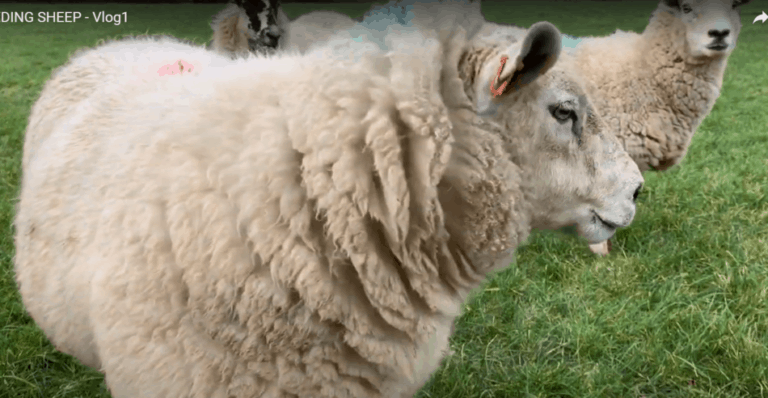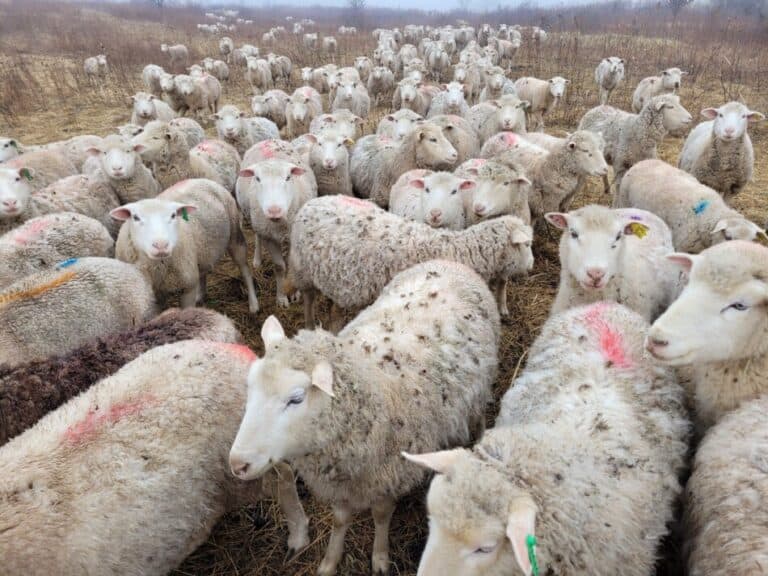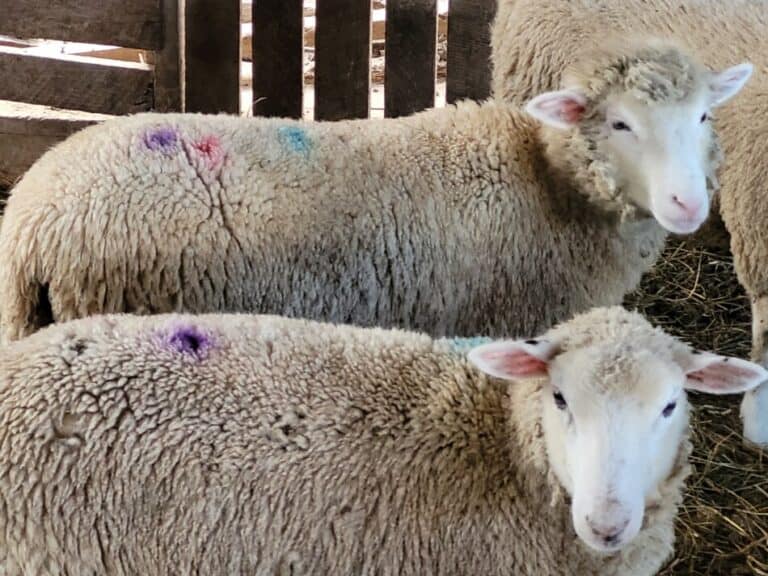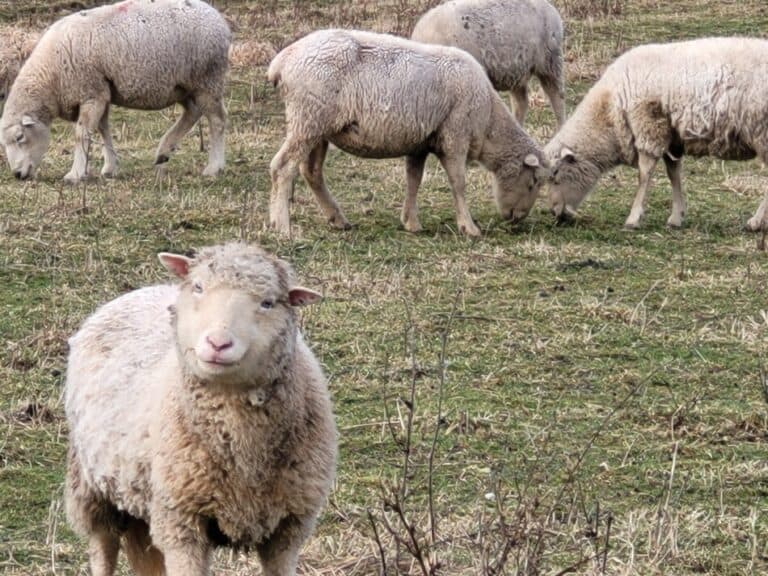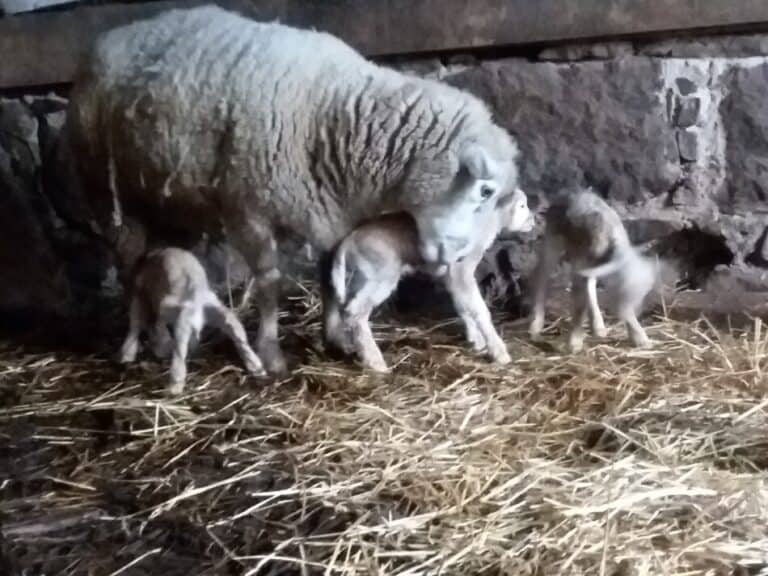Should You Mow Your Sheep Pasture?
Mowing is one of your pasture management tools that you have to decide if, when and where to use.
Sometimes mowing is a great option, other times your pasture would be better managed with a different tool, so how do you decide? Should you mow your sheep pasture or not?

Are the sheep keeping up with the growth?
Let’s start with the forage growth, are your sheep keeping up with the current growth of the pasture?
If it looks like the sheep are keeping up with the growth of the pasture, then there really is no need to mow.
Do Sheep Ruin Pastures? is my article that talks about using sheep to improve your pasture growth.
If pasture has uneven growth
Are you seeing that part of their pasture is overly mature and getting scraggly, while they keep eating back the regrowth from their favorite plants? These sheep have too much space.
You may have to mow down the tall spots in this pasture to stop the less desirable species from taking over. But, better than mowing would be using the sheep to keep up with the grass in the first place.
The problem here is that with the way the sheep are grazing this pasture right now, the grasses or other plants they prefer are getting knocked back repeatedly, which will eventually weaken them.
That’s not great, but the other part that is happening at the same time is worse, the plants the sheep do not like are growing and reproducing like crazy, yikes!
This means you’ll have more of the not so great plants and less of the good plants next year. This is the opposite of what you want to happen in your pastures.
How Many Sheep Can You Have Per Acre? is an article I wrote to help you figure out the number of sheep your land can support.
Give the sheep a section of pasture
So what do you do to fix it? Since your sheep are falling behind with certain parts of the pasture, you can restrict their grazing area by dividing the pasture into sections.
Give them a smaller section of pasture so that they will eat down one area, then be moved to another area while the eaten down pasture is rested so it can regrow.
The resting phase is crucial here, keep the sheep completely off of the first pasture during the rest period.
As crazy as it sounds, the sheep need to be kept off of most of the grass for most of the year.
You need to restrict their movements to direct their eating in a way that best grows and regrows grass. If you let them do whatever, you’ll end up with poorer and poorer pastures each year.
If you have extra grass in one or more of the pasture sections, you can switch between the pasture sections more quickly, make hay or keep the area back as a set aside or drought reserve.
How Do You Make Hay? is my article that goes over the basics of making hay, since that is one of the options for managing your extra pasture growth.

Have a drought reserve area
It’s a good idea to have a section of your pasture set aside in case of low rainfall or poor regrowth, called a drought reserve, which is just stockpiled (uneaten) grass that you keep out of the grazing rotation.
This area will have grown up grasses and some weeds, but that’s okay since you really need it to get you through a tough grazing season.
If you don’t need it in the grazing season, your sheep can use it in the winter. This set aside area is not mowed or partially grazed, your job is to keep the sheep off of it until you need it.
Do you like the plants currently growing?
Do you like the plants that are currently growing in your pastures?
If you like the plants in the pasture:
If so, super, keep on doing what you are doing since that is what is getting you the results you currently have out there.
If you don’t like the plants in the pasture:
If you do not like the plants that are growing in your pasture, you need to do something a bit differently to get different results.
For instance, if you let the sheep eat whatever they want, wherever they want to eat it, they will eat down the tasty plants and leave the less desirables to get even more unappealing to them.
That is the opposite of what you want.
To fix this you have to take more control of the area and either have the sheep graze the sectioned off pasture a bit harder, meaning make the space smaller or mow to knock back the plants they did not eat.
In the long run, improving your management with rotation, adequate rest, and appropriate stocking rates will likely be more viable than continuously clipping underutilized areas.
https://extension.umd.edu/resource/mow-or-not-mow
Sometimes the sheep won’t eat more mature less desirable plants
Mature less desirable plants, also called weeds, can block out the grass growth of an area.
We notice this in some of our harder to reach fields, the non grasses, like goldenrod, that the sheep like when they are just coming up in the spring get too woody later in the year for the sheep to eat.
These less desirable plants need knocked back by mowing to give the grass underneath the opportunity to grow, not so much for the early part of the year, but for the grazing we need later.
This is an easy one to overlook because the plant, goldenrod in this case, is something they like when it is small, but any goldenrod that does not get regularly eaten off grows woody and shades out grass later.
That’s a double problem, since it is growth that the sheep won’t eat and hogging space that could be growing something they would eat, like more grass.

Mow less desirable plants so grass underneath can grow
Not sure what’s under your less desirable plant cover? Mow a strip or two and see what it does. In the case of the goldenrod, this makes a huge difference.
Unfortunately, extra mowing is one more job to do at a time of year when the schedule is already full of things to do, but getting the mowing done seems to make a tremendous difference later.
If you don’t like the results from mowing the area, figure out a different plan like feeding hay there over the winter and see if that works to change the growth the following year.
What is the non edible plant situation?
What non edible plants or weeds are growing in your sheep pasture?
To be clear, I am defining a weed as a plant that the sheep will not eat or that you do not want them to eat, for example something that is poisonous.
The plants in the section above, called less desirable plants, would be eaten by the sheep at some growth stages, but not when mature. These plants are different, they not eaten by the flock, so are called weeds.
How much of your pasture is weeds and is this amount of space growing non edible plants increasing or decreasing throughout the year?
If the weedy area is shrinking, super, you are doing something right, nice work!
Mow to control weeds
What if the weedy areas are growing or you have certain spots or specific plants in the pasture that the sheep seem to avoid?
If the sheep are not being or can not be managed in a way that reduces these weeds, mowing the weeds is an alternative option. Plan to mow the weeds multiple times and maybe for a few years.
For those harder-to-eliminate perennial weeds, although mowing may not be killing them outright, every time the plant is mowed it has to use additional energy for regrowth, draining its energy reserves and weakening the plant over time.
https://extension.umd.edu/resource/mow-or-not-mow
Mowing is probably your best bet if you are dealing with a poisonous weeds, as well. These are more of an urgent problem, since if you don’t knock them back they will reseed and you’ll have more next year!
Another option is to get something in there that will eat the weed. If the sheep refuse that specific weed, would cattle or goats eat it and fix the problem for you?
If the sheep eat it, it’s not a weed
The sheep will eat all kinds of plants that you would not consider first choice options. You may even call that plant a weed, but we figure that if the sheep eat it, it’s not a weed, it’s forage.
Our sheep, for instance, seem to love burdock leaves, so much so that they zoom over and eat these first! To me, those leaves look like a terrible option, but they love the stuff.
If the plants in question were something that the sheep did not eat, then it is a weed and needs mowed so we can knock it back and allow something else that the sheep like to grow there instead.
Is that weed habitat for wildlife?
Anther thing to consider is that the sheep are not the only animals in the pasture. Is the weed in question habitat for something else that you are happy to have or is important to your ecosystem?
For instance, we have quite a bit of milkweed that grows in one of the fields. The sheep eat it somewhat, but it’s really for the monarch caterpillars. (Don’t forget some blooms, like red clover, for the adults.)
We try to leave sections of field, maybe along the edge of a hay field or in a stockpiled area, that has food for the rest of the farm population, like insects, or nesting areas for birds.
While this may look a bit messy for parts of the year, it is important to us to encourage more beneficial wildlife, which does require a place for them to hang out and food for them to eat.
Resources:
For more information on encouraging wildlife in your pasture, read Managing Pasture and Hay for Wildlife by Iowa State University Extension and Outreach.
To learn more about timing of mowing, read To Mow or Not to Mow? from University of Maryland Extension.

